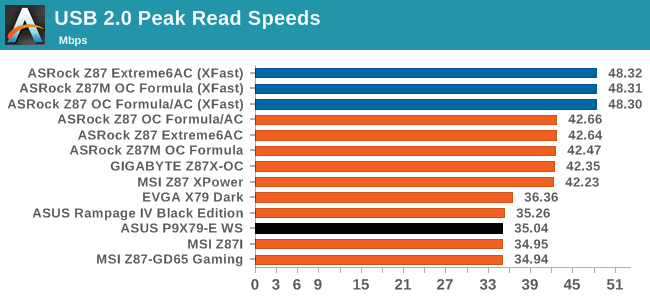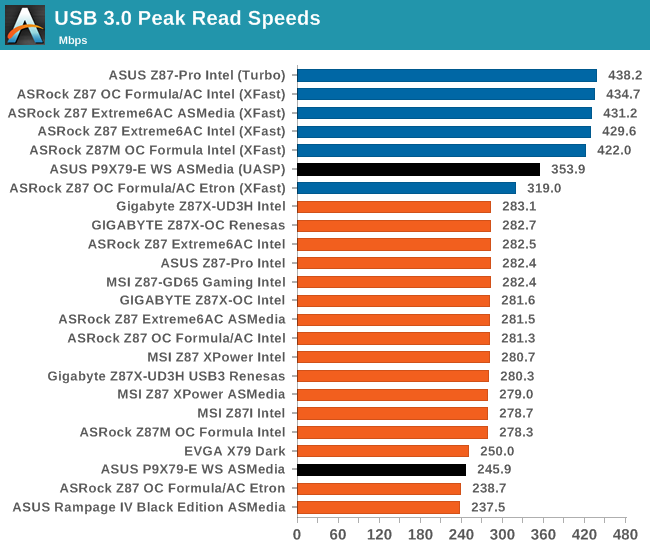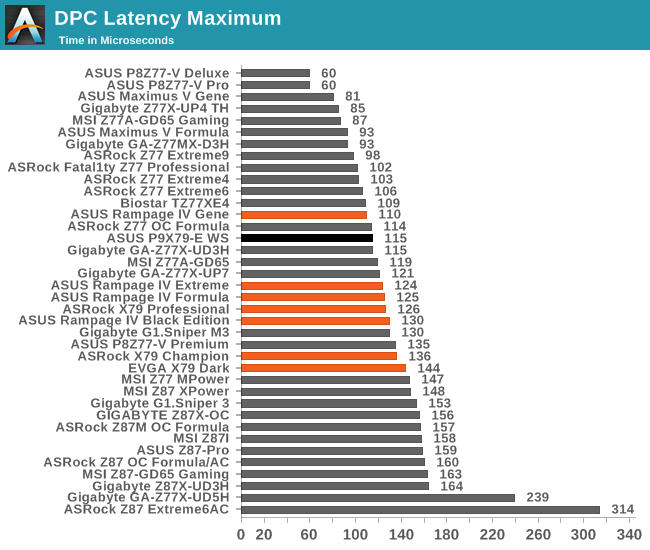ASUS P9X79-E WS Review: Xeon meets PLX for 7x
by Ian Cutress on January 10, 2014 10:00 AM EST- Posted in
- Motherboards
- Asus
- Workstation
- X79
- Prosumer
Rightmark Audio Analyzer 6.2.5
In part due to reader requests, we are pleased to include Rightmark Audio Analyzer results in our benchmark suite. The premise behind Rightmark:AA is to test the input and output of the audio system to determine noise levels, range, harmonic distortion, stereo crosstalk and so forth. Rightmark:AA should indicate how well the sound system is built and isolated from electrical interference (either internally or externally). For this test we connect the Line Out to the Line In using a short six inch 3.5mm to 3.5mm high-quality jack, turn the OS speaker volume to 100%, and run the Rightmark default test suite at 192 kHz, 24-bit. The OS is tuned to 192 kHz/24-bit input and output, and the Line-In volume is adjusted until we have the best RMAA value in the mini-pretest. We look specifically at the Dynamic Range of the audio codec used on board, as well as the Total Harmonic Distortion + Noise.


I expressed my surprise to see the Realtek ALC1150 used on the P9X79-E WS, and even without the extra treatment given to it on some other motherboards it performs better than expected here.
USB Backup
For this benchmark, we run CrystalDiskMark to determine the ideal sequential read and write speeds for the USB port using our 240 GB OCZ Vertex3 SSD with a SATA 6 Gbps to USB 3.0 converter. Then we transfer a set size of files from the SSD to the USB drive using DiskBench, which monitors the time taken to transfer. The files transferred are a 1.52 GB set of 2867 files across 320 folders – 95% of these files are small typical website files, and the rest (90% of the size) are the videos used in the WinRAR test. In an update to pre-Z87 testing, we also run MaxCPU to load up one of the threads during the test which improves general performance up to 15% by causing all the internal pathways to run at full speed.


The lack of native USB 3.0 really does hurt the older platforms especially when trying to bring them into new personas.
DPC Latency
Deferred Procedure Call latency is a way in which Windows handles interrupt servicing. In order to wait for a processor to acknowledge the request, the system will queue all interrupt requests by priority. Critical interrupts will be handled as soon as possible, whereas lesser priority requests, such as audio, will be further down the line. So if the audio device requires data, it will have to wait until the request is processed before the buffer is filled. If the device drivers of higher priority components in a system are poorly implemented, this can cause delays in request scheduling and process time, resulting in an empty audio buffer – this leads to characteristic audible pauses, pops and clicks. Having a bigger buffer and correctly implemented system drivers obviously helps in this regard. The DPC latency checker measures how much time is processing DPCs from driver invocation – the lower the value will result in better audio transfer at smaller buffer sizes. Results are measured in microseconds and taken as the peak latency while cycling through a series of short HD videos - under 500 microseconds usually gets the green light, but the lower the better.

In typical WS fashion, a low DPC Latency is required for DAW users, and at 115 microseconds (peak), the P9X79-E WS does a good job.










53 Comments
View All Comments
mapesdhs - Wednesday, January 15, 2014 - link
Makes perfect sense if you need to build something now. :D I've been talking to a movie
guy who's about to construct something based on this E revision. Similar to mine but better
GPUs, beginning with one 780Ti, expanding to 4 later. Only slight hitch is I've been trying
to convince him to use a Corsair H110 for the CPU instead of a big HS, the latter making
transport more difficult. Either way, it'll be a good AE system until he switches to a dual-socket
24-core XEON setup next year.
The only thing really missing from X79 (apart from a proper 8-core consumer chip option)
is more Intel SATA3 ports which don't suffer from the perils one can encounter with Marvell
ports. Both performance and reliability are better with the Intel ports, in some cases by a
huge margin. People harp on about USB3, but a lot of pro users I know rarely use it and if
they do need a USB link they're usually happy with USB2. Depends on the task though of
course, I'm sure some would find it important.
Ian.
almajnall - Wednesday, January 15, 2014 - link
hidzezik - Monday, February 10, 2014 - link
if You compare this funny mobo with professional supermicro e.g. X9SRL-F (7 PCIe slots for server use) or X9SRA for workstation it looks like a toy for kids. ASUS uses a lot of tricks but it cant overcome 40 lanes limitation from single CPU. motherboard is to complicated. 64GB of RAM is the limit? something is wrong with ASUS, Supermicro support 512GB. If You go for XEON chose Supermicro and Tyanmazzy80 - Friday, February 21, 2014 - link
Actually the SM boards look more like demo sample that a real board with so few surface Caps, Mosfet that this Board. :)The reality that they're not necessary to run the system at stock with the wide margin on Xeon about voltages.
BTW, the 64GB limit is about UDIMM Vs RDIMM, only on the C600 series the RDIMM & UDIMM are supported, on X79 only UDIMM.
P.S.
SM rocks, you can't really go wrong with them for WS/Server rig.
Hale_Kyou - Tuesday, March 4, 2014 - link
The 64 Gb limitation is in Intel Xeon and i7 CPUs, the same. For buffered memory. 500-700 Gb are supported with buffered memory on E5 Xeons only (E7 have hybrid controllers with external components). Buffered memory is MUCH slower than unbuffered due to penalties introduced by buffer and its latent logic. The same, inter-CPU RAM access introduces big penalties on multicore Xeon sustems. That's why sometimes (generally in HPC simulations) single core system with unbuffered RAM is preferred.Hale_Kyou - Tuesday, March 4, 2014 - link
there's a typo. Of course 64Gb limitation is for unbuffered RAM both in Xeon and i7. The limitation is removed on latest server-oriented Atoms.EdB1 - Thursday, July 31, 2014 - link
Hi djezik, although your post is fairly old, I had a look at the two board you mentioned, and they don't have the same PCI-E lanes expansion capabilites as the P9X79-E WS board, which has 72 PCI-E lines, due to 2 additional PLX chips, and can run at 16x x 4 slots at full speed or 2 x 16x and 5 x 8x, the two boards you mentioned do have greater mem capacity though, ie; 512GB ECC vs 64GB ECC or non ECC.So it really depends what you need this board to do. If you want to put 4 x 16X graphics cards in at once and don't need more than the 64GB ram limit, then this is the board to get, but if you do need more that the 64GB then the ASUS should not be considered.
Hale_Kyou - Monday, March 3, 2014 - link
Liars! x79 DOE NOT support "full turbo mode (4.0 GHz) no matter the loading""One new feature called ASUS Ratio Boost is in the BIOS, which implements MultiCore Turbo for Xeon CPUs"
Is a lie, according to ASUS itself. I don't know why did they trick people this dirty way. Maybe Intel pays them for spreading weird rumors. But ASUS says that turbo bins can not be reconfigured on their boards for XEON CPUs!
Hale_Kyou - Monday, March 3, 2014 - link
P.S. Of course it works on i7, that's why they lied about Xeon, but "proofed" with screenshots only with i7X running "all core full turbo".ReneGQ - Thursday, March 13, 2014 - link
I recently purchased an Asus Motherboard and the problems started from day 1. The drivers update never works, the same for AI Suite III (there´s a lot of updates for this model in Asus webpage). After 2 months I still can´t install BitDefender cause a clock watchdog error.Asus technical support is the worst, mails comes and goes with no solution.
I will not recommend this brand to anyone. The brand has a very good Marketing but the product and the service are very disappointment.